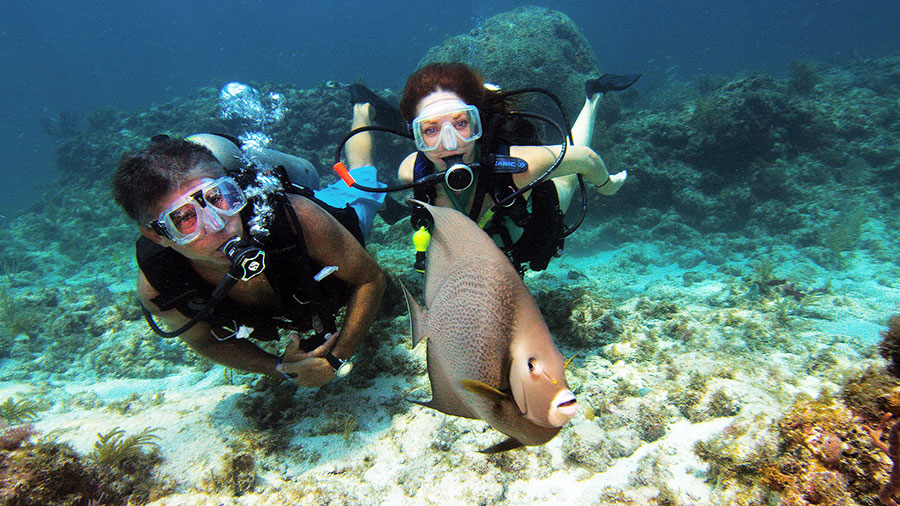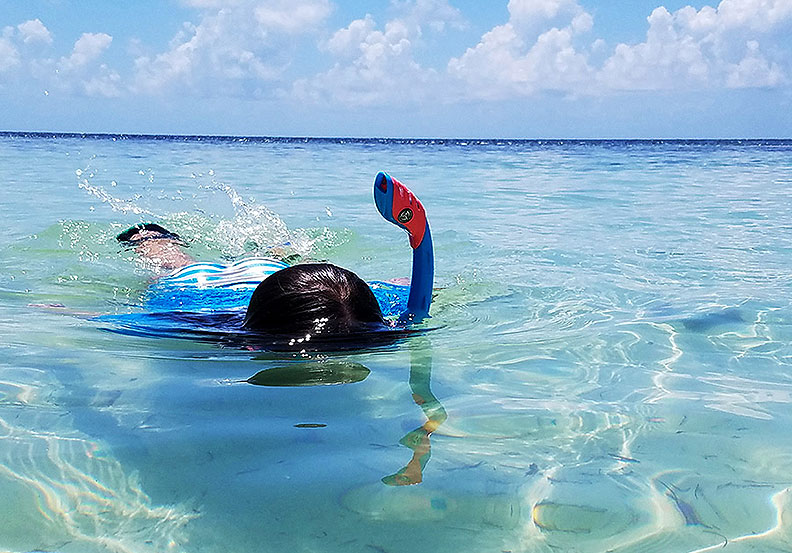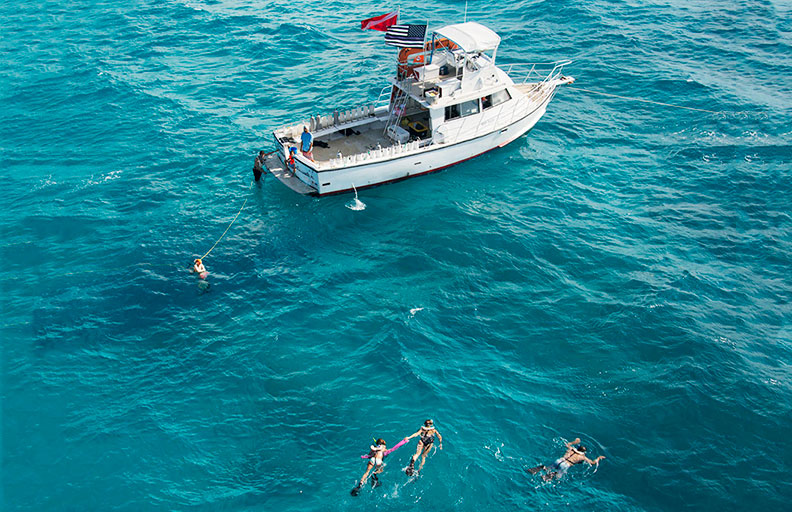RV travelers can hit the Overseas Highway to discover parks close to adventure in the ocean. Set up your camp and dive in the water.
Stretching southwest of Florida, the Lower Keys cluster amid vast expanses of ocean habitat. On land, visitors can revel in the classic, laid-back charm that has helped make the Florida Keys famous. But below the surface, the depths of the surrounding waters make up some of the most exciting diving and snorkeling in the country. These islands are connected by the Overseas Highway (U.S. Highway 1), making them ideal for RVers seeking to trade crowded interstates for clear waterways.
There’s a reason this area is so special for underwater explorers. The area includes large portions of the only living coral reefs within United States territorial waters. Since the 1980s, conservationists have fought for the area’s sustainability, protecting the sensitive ecosystem of the reefs and encouraging marine life to thrive and grow.
For lovers of the water, the Lower Keys give divers and snorkelers a rare opportunity, explains Denise VandenBosch, dive operations director and PADI Master Instructor at Captain Hook’s dive shop in Big Pine Key. “The shallow reef system, unlimited dive sites, short boat ride to the reef (only three miles from shore) and the diversity of the aquatic environment is the perfect combination to make divers and snorkelers feel comfortable,” says Denise.
So get ready to plan your diving or snorkeling getaway to Florida’s Lower Keys. Consult this guide to learn out how to get started and the top places to kick off your underwater journeys.

Diving in the Florida Keys. Photo: Pixabay
The Fundamentals of Diving
No one dives alone. You need experts and the right equipment for your adventure. Fortunately, there are lots of dive shops in Big Pine Key and the Lower Keys offering lessons and tours. If you’re a diving novice, you’ll have to complete an introductory course before heading to the reefs. The quick course teaches you how to use scuba gear (regulator, fins, wetsuit and weight harness) and safety procedures to follow in the water. You’ll also do a practice dive in a pool so you can get accustomed to breathing and moving around with your gear. Once you’ve mastered the basics, you’re ready to get out on the open ocean. A PADI-certified instructor will accompany you the entire time to guide you to different sections of the reef and to help you spot wildlife.
On dive day, remember to pack reef-safe sunscreen, comfortable shoes for the boat and a waterproof camera so you can document every moment.
Getting Started
Don’t let your fears, including claustrophobia, stop you from diving. “Once you’re on the bottom [of the sea], you realize there’s more space down there than there is on land,” says Denise. And don’t worry about sharks, as divers rarely see predatory fish in the water. Even if a shark swims in the vicinity, the bubbles gurgling out of your regulator make enough noise to scare it away. “We are certainly not on their menu — we are big, bubbling, noisy, camera-flashing visitors to their waters and we’re of no interest to them at all,” says Denise.
Get Deep into Diving: Get Certified
The thrill of diving can be addictive, and many people get hooked after their first experience. If you become obsessed with this pastime, consider becoming a certified open-water diver. This lifetime certification requires four to seven days to finish and builds the skills you need to dive without a licensed instructor. The curriculum consists of an online portion, confined water dives and open water dives. Participating divers must be at least 10 years old. Denise believes that this is a perfect age to introduce your kids to diving. “Most families get certified together and parents get to raise their best dive buddies,” she says.
Snorkeling: An Easy Alternative
Seeking a more laidback way to explore the water? Snorkeling may be the answer. If you’re a snorkeling newbie, you’ll be happy to know that extensive training isn’t needed. And if you’re comfortable swimming in deep water and don’t mind breathing through a tube, you’ll discover an underwater paradise in the keys. The warm, tropical waters make for a comfortable experience, but if you go on a snorkeling tour, always heed the instructions of your guide. Stay within your comfort zone and enjoy the nature that surrounds you.

Bahia Honda State Park is a hidden gem for snorkling the Florida Keys. Photo: Dawn Sunshine
Top Diving and Snorkeling Spots in Florida’s Lower Keys
1) Looe Key Marine Sanctuary
“You’ll never be disappointed with any dive you make at Looe Key,” says Denise. Looe Key sits six miles south of Big Pine Key and is a National Marine Sanctuary protecting the only complete reef ecosystem in the continental United States. Environmental laws enacted in 1981 banned spearfishing, coral collection and lobstering in the area. As a result, the reef has flourished into one of the most spectacular dive sites in North America. Go underwater and hang out by the steep coral formations to spot angelfish, turtles, eagle rays and more. According to Denise, “all the sea critters are well aware they are protected” and won’t hesitate to swim right up to your mask. Not interested in diving? Try snorkeling instead. You’ll still get to enjoy close-up views of the reefs and wildlife from along the water’s surface.

Snorkelers explore Florida Keys National Marine Sanctuary. Photo: Andy Newman/Florida Keys News Bureau
2) Adolphus Busch Shipwreck
The 210-foot Adolphus Busch ended its cargo-carrying career when it was intentionally sunk seven miles from Big Pine Key in 1998. But the vessel took on a new duty as home to a diverse array of vibrant marine life. Divers come from around the world to go under the surface to swim with swirling schools of silversides, barracudas and horse-eye jacks. You also might catch a glimpse of southern stingrays if you go all the way to the ocean floor. Before you head back to the surface, say hello to the residents in the vessel’s cargo holds. Tenants here include green moray eels and 350-pound goliath groupers (don’t let the name scare you — they’re gentle giants).
3) Bahia Honda State Park
Head over to Bahia Honda Key, where Bahia Honda State Park serves as an excellent training ground for new snorkelers because of its protected and shallow waters. On the island, you can rent all necessary gear from the local dive shop and go for a swim at Bay Side Beach. Discover the fish that flourish near the Bahia Honda Bridge, a 5,055-foot railroad span that connects Bahia Honda with Spanish Harbor Key to the west. You’ll also discover beautiful spots near the wall at the end of the beach. Boat trips to Looe Key launch from the park, so sign up for one after you’ve gotten accustomed to snorkeling.
4) Boca Chica Key
Located just south of Boca Chica Key, the Western Sambo Ecological Reserve is a dream come true for both divers and snorkelers. Occupying nine square nautical miles, the area encompasses the highest habitat diversity in the Lower Keys. It also has the region’s last remaining stands of elkhorn coral, which can be found in the grassy bed areas of Western Sambo Reef. Another destination worth exploring is Cannonball Cut on the east side of the reef. This is where you’ll discover the Aquanaut tugboat wreck along with spiny lobster and massive star coral. Haystack and the Hawk Channel are excellent spots too if you’re searching for tropical fish.
5) Cudjoe Key
Situated about nine miles west of Big Pine Key along the Overseas Highway, Cudjoe Key is the place to go to get off the beaten path. About 1,800 residents live on the 6-square-mile key, and visitors can expect a quiet snorkeling experience without big crowds. Adventurers can rent a boat from Cudjoe Gardens Marina (or launch the boat that you’ve been towing from the ramp) and voyage off the coast to swim with parrotfish, sergeant majors and angelfish. In all, there are more than 150 species of exotic fish inhabiting the area. Equally impressive are the reef’s corals, especially the brain, star and fire varieties.
Bonus: The Lower Keys aren’t renowned for shore diving, but locals are happy to point you to one particular spot. Mile Marker 35 on the Overseas Highway is a calm area protected by the wind and an excellent place for a walk-in dive if the weather isn’t good enough to go boating.
RV travelers will find lots of camping opportunities in the Florida Keys, with most parks close to the Overseas Highway. Set up camp and hit the water.
For More Information
Learn more about Florida’s Lower Keys.

